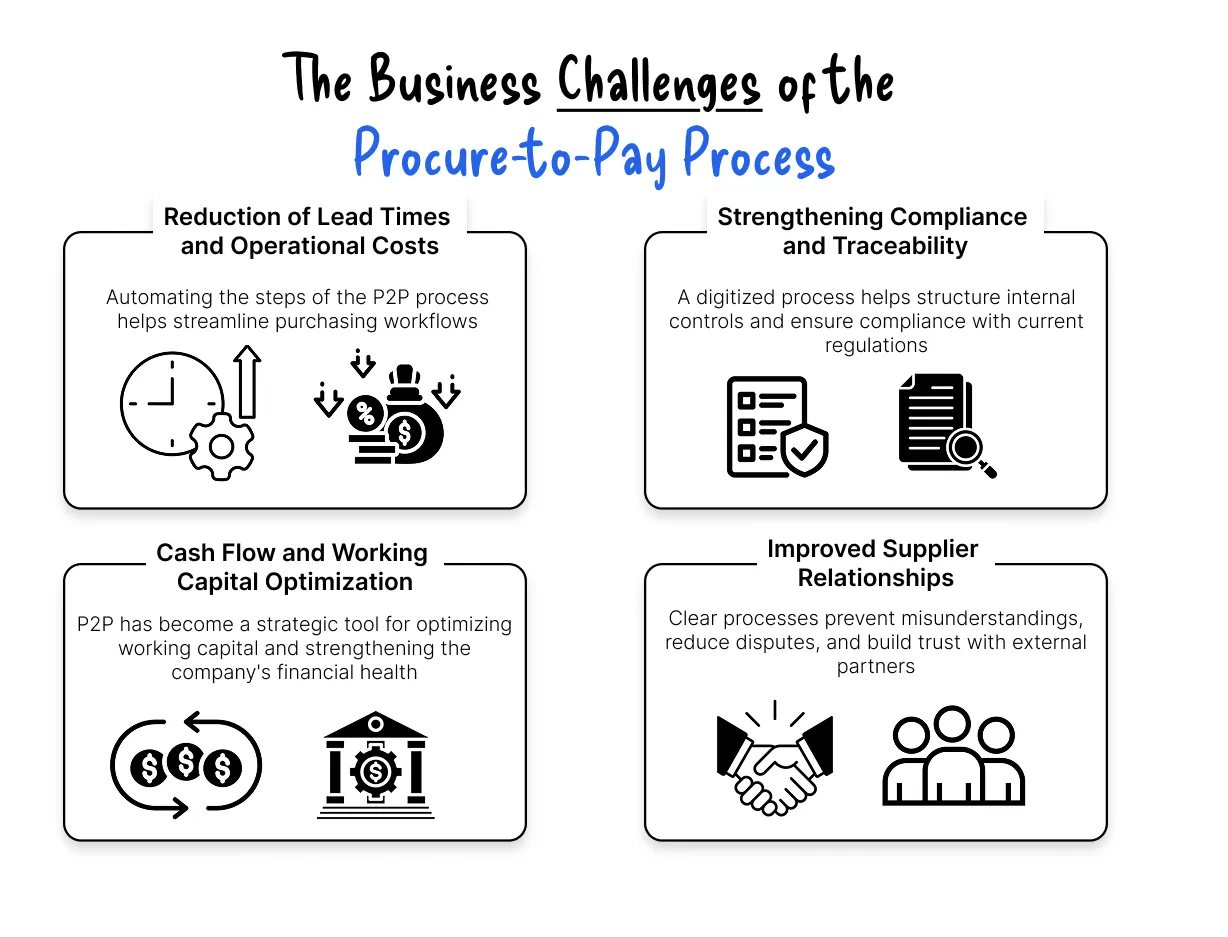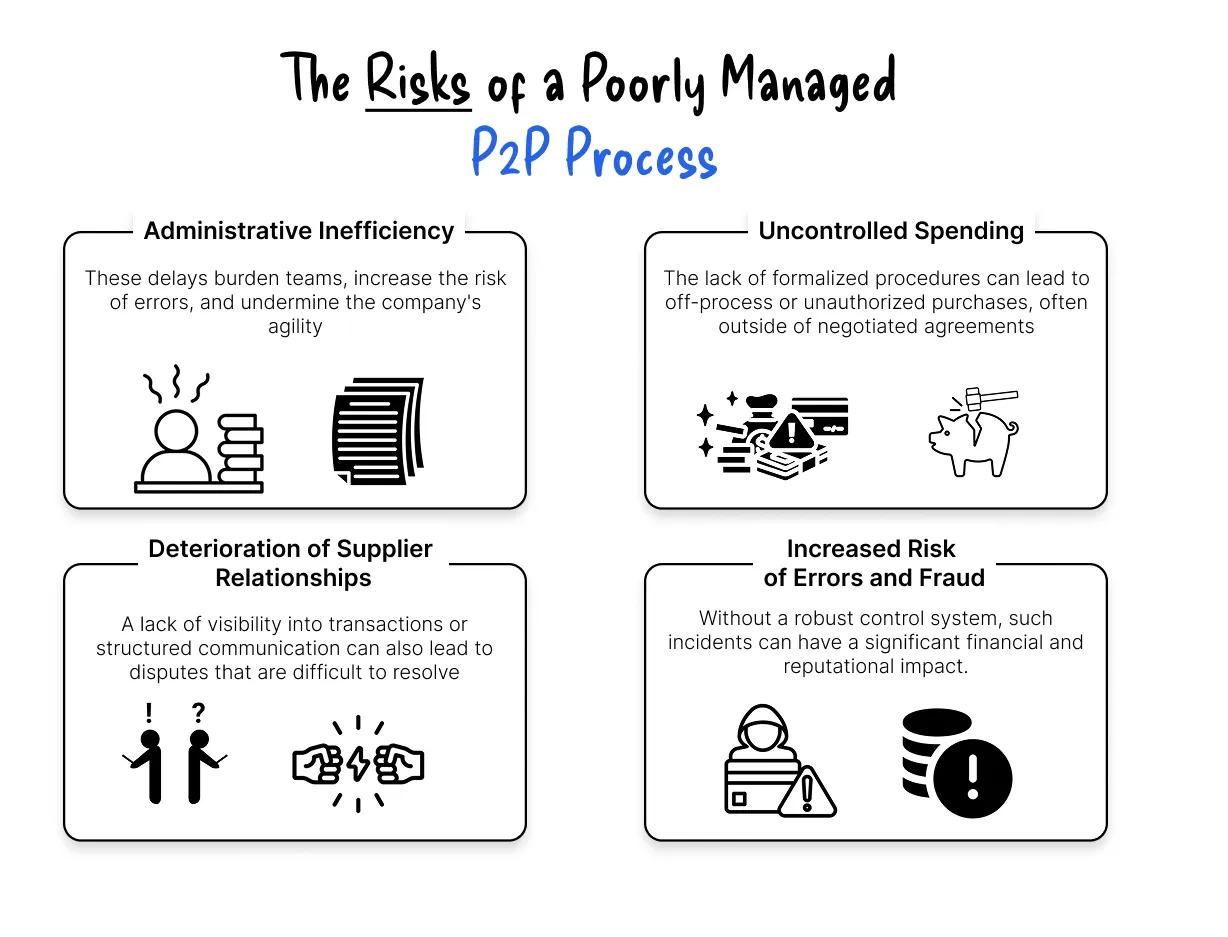
The European AI Act frames AI through risk. Learn what's changing for businesses, sanctions, and decisions to make.
Glossary
Dernière mise à jour :
November 5, 2025
5 minutes
From need to invoice, each stage of P2P can be automated to speed up flows, secure payments and improve supplier relationships. Learn how to get the most out of this process.
Learn how the Procure-to-Pay (P2P) process automates purchases and payments, reduces costs, and optimizes cash flow. A complete guide to structure your flows and improve performance.
The Procure to Pay (P2P), also called Purchase-to-Pay, refers to the entire purchasing process from the expression of the need to the payment of the supplier.
This process is intended to allow businesses to acquire the necessary goods and services at cost while optimizing margins at each stage.
To achieve this, they must set up a structured purchase flow, covering all stages: definition of needs, selection of suppliers, negotiation, contracting, receipt of invoices, and payment.
The Procure to Pay (P2P) cycle is generally based on 7 key steps, widely disseminated through specialized solutions and good industrial practices:

A department detects a need for goods or services in line with the company's goals and budget. This first phase is essential to avoid superfluous or unbudgeted purchases.
The need is formalized in the form of a purchasePurchase request, subject to validation. It may include product research, shopping carts, and budget receipts. Approval guarantees internal and budgetary compliance.
After approval, a purchase order is generated and sent to the supplier. This contractual document specifies quantities, prices, deadlines, and conditions.
Upon delivery, a receipt note is generated. The company verifies the conformity, quality, and quantity of the products or services received.
The supplier dispatches an invoice, which the system records. It is then aligned with the PO and the receipt of goods (process of three-way matching).
The invoice is validated if no discrepancies are detected. Then, it is sent to the accounting department for payment according to the contractual terms (bank transfer, card, etc.).
The process is completed with payment confirmation, complete registration in the accounting system, and supplier performance monitoring. This data feeds into reports and analyses.
A well-orchestrated Procure-to-Pay process represents a strategic lever for improving the overall performance of a company.

By eliminating manual interventions (entries, reminders, reconciliations), businesses save time and reduce administrative costs. The ability to handle a larger volume with the same resources directly improves productivity without burdening teams.
Each action (validation, approval, modification) is traced, facilitating audits, fiscal audits, and internal controls. Compliance with contracts and payment deadlines is also becoming more systematic.
Precise management of supplier deadlines makes it possible to anticipate disbursements, negotiate discounts, or delay payments without the risk of penalty.
By respecting payment deadlines and facilitating documentary exchanges, the company strengthens its reputation and position in the supply chain.
On the other hand, a poorly structured or too manual P2P process exposes the company to numerous flaws, both operationally and strategically.

Repetitive and non-automated tasks, such as manual data entry or email reminders, slow down daily operations. These delays weigh on teams, increase the risk of errors, and hinder business agility.
The absence of formalized procedures can lead to out-of-process or unauthorized purchases, often outside of negotiated agreements. These practices reduce visibility on commitments, complicate budget monitoring and can generate unnecessary additional costs.
A poorly managed P2P delays invoice processing, causing late payments, penalties, and tensions with suppliers. The lack of visibility into transactions or structured communication can also lead to disputes that are difficult to resolve.
Manual or insecure processes facilitate input errors and expose the company to fraud: duplicate payments, fictional invoices, unvalidated suppliers, etc. Without a robust control system, these incidents can have a heavy financial and reputational impact.
Optimizing the Procure-to-Pay (P2P) cycle is a strategic lever for gaining operational efficiency, reducing costs, securing transactions, and strengthening supplier relationships.
The transition from a manual process to digital management makes it possible to streamline each stage: purchase requests, approvals, orders, receipts, invoices, and payments. Thanks to automation:
Solutions centralize all documents (order forms, invoices), automate their collection, and guarantee rigorous monitoring on a unified interface.
Businesses have two approaches:
Regardless of the option chosen, the challenge is to ensure a smooth integration with the existing information system to avoid duplicates and ensure digital continuity.
The integration of technologies such as OCR (Optical Character Recognition) and IDP (Intelligent Document Processing) allows:
Smart platforms like Koncile combine OCR and intelligent processing for Automatically classify, extract, and structure data complex documents. They make document processing more fluid, while facilitating the direct integration of information into accounting or ERP systems.
Optimizing P2P also requires better financial visibility. Visualizing the deadlines in a cash flow plan allows you to:
Thanks to certain solutions, it becomes possible to adjust disbursement flows in real time according to available cash flow.
A clean and structured supplier framework is fundamental. It is essential to maintain:
One clear data governance, with defined roles, controls and validations, reduces the risks of fraud, avoids payment errors and makes analyses more reliable.
Performance analysis allows for continuous improvement. Key indicators include:
These KPIs make it possible to identify “bottlenecks” and to optimize processes continuously.
An effective P2P process is based on fluidity of exchanges :
Allowing everyone to access up-to-date information, track transaction status, or submit documents online improves productivity and partner satisfaction.
P2P only covers the operational chain from the purchase request to the supplier's payment. As for S2P, it includes strategic sourcing at the outset, i.e., the selection, evaluation, and contracting with suppliers. In summary, S2P encompasses P2P with a broader vision of procurement strategies.
Yes, there are modular P2P solutions that can integrate with existing ERPs without replacing them. These tools use connectors or APIs to synchronize data in real time, making it possible to benefit from automation without changing the company's IT architecture.
The ROI of a P2P project can be measured through several indicators: reduction of processing times, reduction of administrative costs, improvement of the compliance rate, reduction of supplier disputes, or even cash flow gains. A before-and-after analysis over a few months is often enough to demonstrate tangible benefits.
A well-structured P2P process makes audits much easier, whether internal or external. The traceability of each stage, the archiving of documents, and the standardization of flows make it possible to quickly meet the requirements of auditors and to prove the conformity of expenses.
Move to document automation
With Koncile, automate your extractions, reduce errors and optimize your productivity in a few clicks thanks to AI OCR.
Resources

The European AI Act frames AI through risk. Learn what's changing for businesses, sanctions, and decisions to make.
Glossary

Koncile is elected startup of the year by ADRA. The solution turns procurement documents into actionable data to detect savings, monitor at scale, and improve strategic decisions.
News

Why LLM OCR replaces outdated OCR and powers modern document automation.
Comparatives